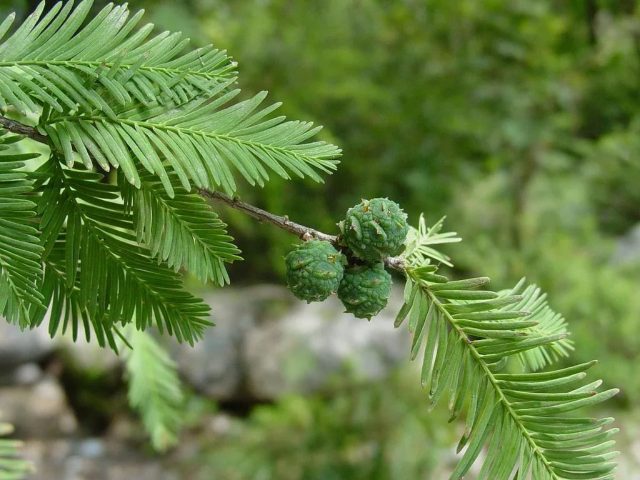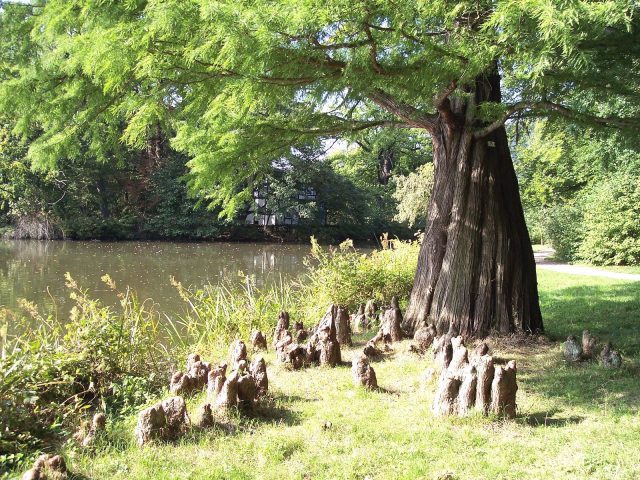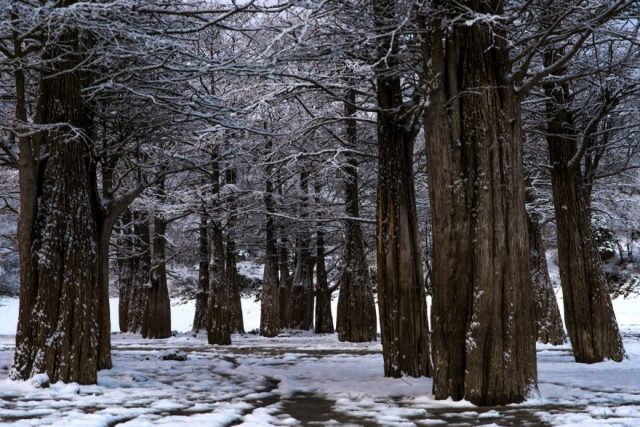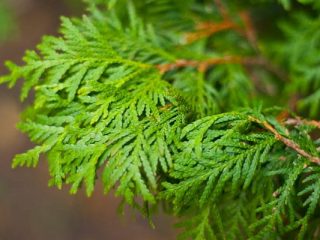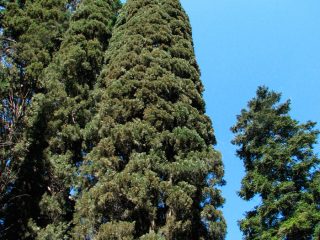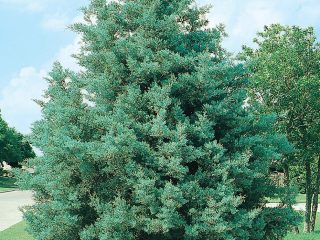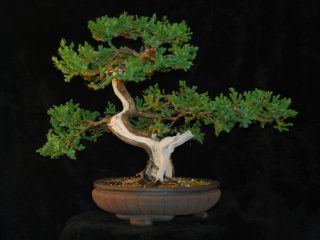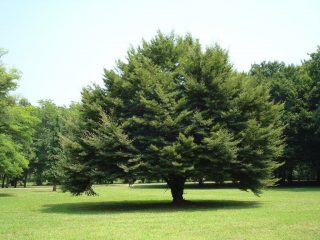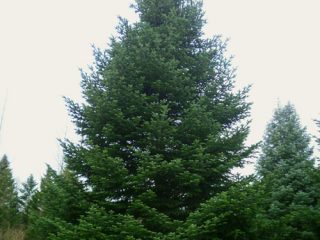Content
Swampy cypress grows in the wild in areas with a subtropical climate, but you can even try to plant a strange plant in your summer cottage. The tree is characterized by rapid growth, prefers a humid, warm climate and requires little or no maintenance.
Description of swamp cypress
Marsh cypress (taxodium two-rowed) is a deciduous coniferous tree belonging to the Cypress family. Its height reaches 30-36 meters, the thickness of the trunk in diameter can vary from 1 to 5 m. The bog cypress is considered a long-liver, the plant's life span is 500-600 years.
The trunk of young trees is knotty, the crown is narrow-pyramidal. With age, the trunk of the bog cypress acquires a cylindrical shape, and the crown - a pyramidal or wide-spread shape. The bark of the tree is 10 to 15 cm thick, dark red-brown in color, has longitudinal deep cracks. Shoots can be elongated or shortened.
The openwork, slightly sagging shoots of the marsh cypress are covered with soft, feathery, linear leaves of a light green hue, which have a rounded sharp top and resemble needles in appearance. The length of the leaves is 16 - 18 mm, the thickness is 1.5 mm, the arrangement is two-row (comb). In the autumn, the foliage of the marsh cypress acquires a reddish, rusty color and falls off along with the shortened shoots.
On the shoots of cypress, rounded green cones with a diameter of 1.5 to 4 cm, which are formed from spirally arranged scales, also ripen. Taxodium is a monoecious plant. Female cones grow at the ends of the shoots. After ripening, they turn brown and crumble. There are 2 seeds under the scales. Male cones are located on the upper branches of the last year, the length of which is approximately 10 - 14 cm.
Marsh cypress roots form unusual outgrowths on the surface, which are conical or bottle-shaped and are called respiratory roots - pneumatophores. They are able to rise several meters above water or a swampy soil surface, supplying the underground parts of the plant with air. Trees growing in drier soil do not have these roots.
Swamp cypress feels comfortable in moist soils without lime, loves light and calmly tolerates cold snaps down to -30 oC. Taxodium is extremely resistant to decay and many pests and diseases. However, marsh cypress does not tolerate polluted, gassed air. The plant does not tolerate drought.
Where does swamp cypress grow?
In nature, bog cypress is often found along the banks of slow-flowing rivers. Swamp cypress also grows in the southeastern swamps of North America. The plant was brought to Europe in the 17th century, and the bog cypress came to Russia only in 1813.
In 1934, on an artificial dam in the gorge of the river. Sukko created a cypress grove consisting of 32 trees. Currently, the Cypress Lake is considered a monument of regional significance.
Swamp cypress is able to grow in soil with a high level of moisture, in river deltas. You can meet bog cypress in natural, natural conditions in the Danube Delta, in the Crimea. Currently, the culture is actively cultivated in the regions of Central Asia, in Uzbekistan.The Krasnodar Territory, Kuban and the Black Sea coast of the Caucasus are also recommended for cultivation.
Swamp cypress in landscape design
Swamp cypress is considered a valuable forest species; recently, an outlandish tree is increasingly used in landscape design as a park plant. It is ideal for decorating ponds, forming park alleys. Swamp cypress will feel comfortable in swampy, flooded areas, in oxygen-depleted soil.
In combination with marsh cypress, virgin juniper, beech, cedar, ferns, sequoia, oak, maple, linden, hops, birch, willow and pine look good. Planting a plant next to a larch is not recommended. When forming a coniferous composition, it should be oriented in the western or eastern direction.
Planting and caring for swamp cypress
Despite the fact that the taxodium is very fond of light and needs bright lighting in winter, it needs light partial shade in hot summer. For planting swamp cypress, the south side of the site is a good choice. The tree quickly grows to a large size, so the planting space should be spacious enough.
Preference should be given to wet soil, the taxodium can be planted in an area next to a small lake or pond. In such conditions, the plant will feel most comfortable. Planting is done in the spring, before the buds begin to bloom on the trees.
Seedling and planting plot preparation
Swamp cypress is quite picky about the composition of the soil. He needs a well-moistened and nutrient-rich sandy loam soil with a neutral acidity level. Taxodium does not like lime. A soil mixture is ideal:
- from 2 parts of humus;
- 2 pieces of turf;
- 2 parts of peat;
- 1 part river sand.
Taxodiums should not be transplanted with bare roots. When buying a seedling, it is necessary to check that there is a clod of earth and packaging made of canvas or burlap on the root system.
Landing rules
Landing Algorithm:
- Dig a planting hole. Swamp cypress has a powerful root system, so the depth of the planting pit should be at least 80 cm.
- Drain the pit with sand or chipped bricks. The recommended thickness of the drainage layer is at least 20 cm.
- Add nitrophoska at the rate of 200 - 300 g per tree.
- Place the seedling in the hole so that the root connects to the stem at soil level. It is important not to damage the earthen lump when transplanting.
- After transplanting, the marsh cypress will take some time to take root. During this period, the plant should be watered regularly and abundantly.
Watering and feeding
In the summertime, marsh cypress needs abundant watering; one plant will need at least 8-10 liters of water. Sprinkling in the summer should be carried out at least 2 times a month. Water the plant once a week, and on sandy soil every other day.
After planting, taxodium should be fed annually with Kemira-universal fertilizer at the rate of 150 mg per 1 sq. m. After three years of feeding, it is recommended to apply 1 time in 2 - 3 years.
Mulching and loosening
Swamp cypress does not need to loosen the soil, because it has respiratory roots-pneumatophores, which provide the plant with the necessary air. Gently loosen the soil only if, after the spring thaws and melting of snow, a crust has formed on the surface of the earth: this will help the taxodium to better absorb and retain moisture.
For mulching taxodiums are used: needles, pine bark, sawdust, straw and hay.Swamp cypress must be mulched after planting; young trees are also recommended to be mulched for the winter.
Pruning
The taxodium does not need pruning. You can even say that for this plant, branch cutting is contraindicated: after such a procedure, it becomes more difficult for it to adapt to sharp autumn temperature drops and survive the winter. The shortened shoots, together with the needles, fall off on their own in the autumn.
Preparing for winter
Adults calmly endure wintering and short-term cold snaps below -30 oC. Young trees are too weak and fragile, they hardly survive winter frosts, therefore they need additional protection. To prepare young plantings for winter? they must be covered with a layer of dry foliage about 10 cm thick.
Reproduction
In nature, the reproduction of marsh cypress is carried out by means of seeds. At the summer cottage, the taxodium, as a rule, is more often propagated by grafting and grafting. However, the best option is to buy ready-made seedlings in special containers. Transplanting to a permanent place should be done exclusively at a young age, since the taxodium is characterized by the rapid growth of the taproot.
When planting with seeds for hardening, it is worth stratifying them. To do this, they must be put in the refrigerator and stored at a temperature from +1 to +5. oC for 2 months. For sowing seeds, peat, river sand and forest litter are mixed in equal parts. The depth of the seed box must be at least 15 cm, otherwise the taproot begins to bend as it grows, and this leads to the death of the plant. After a few years, the seedlings will be ready for transplanting.
Diseases and pests
Swamp cypress is considered to be extremely resistant to diseases and pests, only a few varieties of Hermes threaten it. If insects are found, the affected parts of the shoots are cut off and burned. The remaining pests are washed off with a strong pressure of water.
Rot and various types of fungi characteristic of wetlands are not terrible for the taxodium: water is considered the plant's native home. It is only important to make sure that the bark of the tree does not crack.
Conclusion
Swamp cypress is an exotic tree from which landscape compositions of extraordinary beauty are obtained. Caring for it is easy, since all the plant needs is a well-moistened, swampy soil and regular watering.

